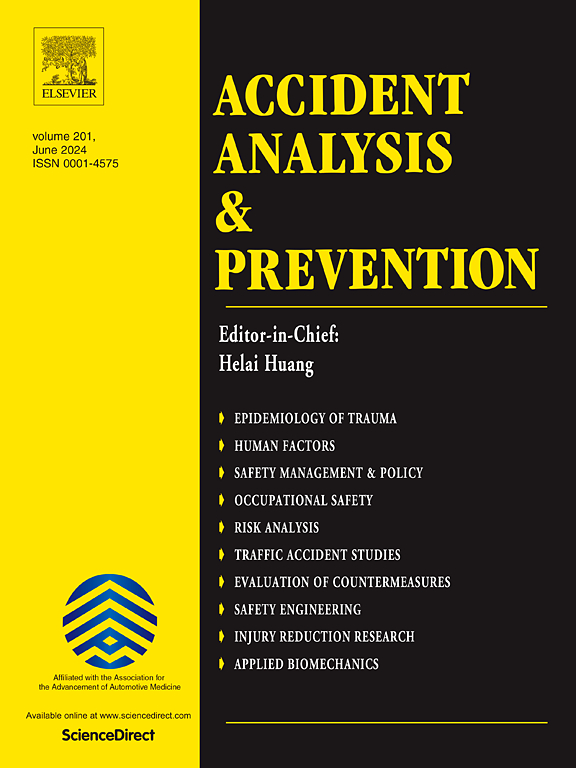不稳定通信环境下面向安全与效率的网联自动驾驶车辆自适应策略控制
IF 6.2
1区 工程技术
Q1 ERGONOMICS
引用次数: 0
摘要
在高质量通信环境的前提下,互联和自动驾驶汽车(CAV)在提高交通安全、效率和环境可持续性方面显示出巨大的潜力。然而,由于现实生活中的意外干扰,车辆通信往往存在信息传输不稳定的问题,降低了自动驾驶汽车队列的性能。尽管存在这些缺陷,但现有的研究对不稳定通信环境下的自动驾驶汽车队列问题缺乏足够的重视,且很少涉及响应策略。为了填补这些研究空白,本研究基于改进的智能驾驶员模型(IDM)和设计用于模拟UCE的通信干扰框架生成的仿真数据,将动态通信拓扑集成到自动驾驶和/或联网车辆的多类控制中,以响应各种数据异常。从交通安全和效率两方面评价了UCE对自动驾驶汽车队列性能的影响。该研究介绍了五种自适应动态策略控制(ADSCs)和三种混合切换ADSCs,以提高不同UCE条件下的排性能,并提出了在不同UCE情况下保持排性能的适用ADSCs的建议。此外,我们对衰减模型参数的敏感性分析确定了开发ADSCs的最佳配置。结果表明,与间歇性UCE (IUCE)相比,连续UCE (CUCE)存在更大的安全性挑战,其中联合IUCE最有害。涉及侵略性加速行为的场景显著增加了队列内的碰撞风险和速度振荡。所提出的混合切换ADSCs显著提高了自动驾驶汽车的队列性能,提供了弹性和自适应的车辆控制策略,以平滑干扰下的交通流。本文章由计算机程序翻译,如有差异,请以英文原文为准。
Safety and efficiency-oriented adaptive strategy controls for connected and automated vehicles in unstable communication environment
Connected and automated vehicle (CAV) has demonstrated significant potential in enhancing traffic safety, efficiency, and environmental sustainability in the premise of high-quality communication environment. However, attributed to unexpected disturbances in real life, vehicular communication often suffers from unstable information transmission that lowers the performance of CAV platooning. Despite this drawback, existing research lacks sufficient attention on CAV platooning in the presence of unstable communication environment (UCE) and rarely addresses the response strategies. To fill these research gaps, this study integrates dynamic communication topologies into multi-class controls of automated and/or connected vehicles in response to various data abnormalities, based on simulation data generated from the modified intelligent driver model (IDM) and the communication disturbance framework designed to emulate UCE. The impact of UCE on CAV platooning performance is evaluated in terms of traffic safety and efficiency. The study introduces five adaptive dynamic strategy controls (ADSCs) and three hybrid switching ADSCs to enhance platoon performance under varying UCE conditions, along with recommendations on applicable ADSCs for maintaining the platoon performance under different UCE scenarios. Also, our sensitivity analysis of attenuation model parameters identifies optimal configurations for the development of ADSCs. Results show that continuous UCE (CUCE) poses greater safety challenges compared to intermittent UCE (IUCE), with combined IUCE being the most detrimental. Scenarios involving aggressive acceleration behavior significantly increase the collision risk and speed oscillation within the platoon. The proposed hybrid switching ADSCs significantly improve CAV platoon performance, offering resilient and adaptive vehicle control strategies to smooth traffic flow under disturbances.
求助全文
通过发布文献求助,成功后即可免费获取论文全文。
去求助
来源期刊

Accident; analysis and prevention
Multiple-
CiteScore
11.90
自引率
16.90%
发文量
264
审稿时长
48 days
期刊介绍:
Accident Analysis & Prevention provides wide coverage of the general areas relating to accidental injury and damage, including the pre-injury and immediate post-injury phases. Published papers deal with medical, legal, economic, educational, behavioral, theoretical or empirical aspects of transportation accidents, as well as with accidents at other sites. Selected topics within the scope of the Journal may include: studies of human, environmental and vehicular factors influencing the occurrence, type and severity of accidents and injury; the design, implementation and evaluation of countermeasures; biomechanics of impact and human tolerance limits to injury; modelling and statistical analysis of accident data; policy, planning and decision-making in safety.
 求助内容:
求助内容: 应助结果提醒方式:
应助结果提醒方式:


